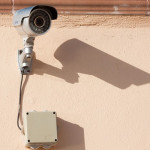Motion Detection: How It Works
Security cameras equipped with motion detection can be very helpful for home and business owners. Motion sensor cameras allow users to rest easy knowing the built-in sensors will alert them when activity is detected, eliminating the need for monitoring live feeds around the clock.
While motion detection can be very convenient, it can also prove to be a nuisance. False alarms caused by various reasons, such as pets, natural environmental changes, or even changes in lighting, can be frustrating, confusing, and a waste of time. In order for you to make the most of the motion detection feature, here’s what you need to know.
Types of Detection
While there are many different technologies that detect motion (ex. light pulses, thermal measurements, radio waves), for consumer security cameras, there are two methods that are commonly used.
Passive Infrared (PIR)
This method detects the ambient heat emitted by all living beings and is sometimes referred to as “heat vision.” The sensor is triggered when it detects enough movement of these warm “objects” and/or a significant temperature disparity between the object and the background scene. When triggered, it signals the security camera to start recording, and thus, the user is alerted.
Computer Vision (CV)
This approach involves camera software that analyzes sequential frames of live video for differences and registers a motion event when a significant change is detected. With that said, CV includes many different methods, which depend on the desired outcome and technical preference of the designers.
Of these methods, one of the easiest involves looking for a significant change in pixels over short periods of time compared to the longer term average. This will produce a simple ‘something happened’ signal. Another method tracks groups of pixels and tries to identify directional patterns in order to recognize moving objects.
What all of these methods have is common is the end goal – to detect motion and, if possible, determine the shape of the object that moved. Once that goal is achieved, more advanced methods can be applied to classify the moving object (ex. person, animal, vehicle, tree) to determine which detection signals are important (ex. person or vehicle) or irrelevant and can be dismissed (ex. animal or tree).
Pros & Cons
- PIR sensors are more reliable than CV-based cameras when it comes to filtering out insignificant activity (ex. curtains fluttering in the breeze from a nearby fan, change in the light streaming through a window)
- PIR is power efficient, thus often used in battery-powered cameras. PIR keeps these cameras them in a low-power, non-recording state until the PIR sensor detects motion. When motion is detected, they switch to a high-power recording state for a fixed period of time (ex. to capture a 30 second video clip) or until motion stops.
- The low-power mode of PIR can be a disadvantage as it may take more time to wake up and start recording than CV-based cameras. Consequently, you may miss part of the action that triggered the motion alert, such as the intruder’s approach when their face is most visible, which matters with forensic evidence. By nature, they are also incapable of detecting motion through glass, thus are not suitable for scenarios such as monitoring your yard with an indoor cameras aimed through a window.
- CV motion detection provides greater analysis of the scene and for identification of the object creating motion through advanced features (ex. person detection, facial recognition). However many of the algorithms that make this possible are too computationally intensive to run locally on the camera. Instead, they are computed on remote servers in the cloud, where they often can only be unlocked with a paid subscription, which can add significantly to the total cost of ownership of the camera.
- Because CV detection is also dependent on the quality of the algorithms, it is also more susceptible to false alarms. That is, any large change (ex. spinning ceiling fan, leaves blowing outside window, change in ambient lighting) can register as motion.
False Alarms
Of course, false alarms are one of the most frustrating downsides to motion detection. Luckily, manufacturers are aware of this and offer different ways to reduce these instances.
- PIR cameras usually allow users to adjust the sensitivity level within the accompanying app so that more- or less-pronounced motion triggers the sensor. For example, reducing the sensitivity level could require a moving object to be warmer or closer to the camera for it to be triggered.
- CV offers more options for combating false alarms. A popular option is to set motion detection zones, which basically allows you to tell your camera to ignore activity in certain parts of the field of view while focusing on specific areas for motion. This approach is fairly effective as your camera can focus on windows and doors (where breaches are most likely to occur) rather than the activity within your home.
- Based on the geometric properties of a moving object, CV is able to make quick judgment calls. For example, something very small relative to the field of view is either a small object (ex. a floating dust mote) or a larger object far away, both of which are not cause for triggering any sensors.
- With more advanced technology, CV-based cameras may also include person detection or facial recognition to decrease false alerts. Both technologies require a pre-existing database of recognized individuals and usually require a few weeks of use before accurate results are produced. And while these features are advanced, they are only as strong as the algorithms behind them (which is why different cameras with facial recognition can produce different results).
Motion detection is still a work in progress, and at this point, you likely get what you pay for. The good news is that our technologies are always improving, thus, motion detection has the potential for greatness on the future.
What are your thoughts on motion detection security cameras? Have you had success or failure with them? Share your experiences with us on Facebook, Google+, Twitter, LinkedIn, and Pinterest.
Visit SecurityCamExpert.com to browse our wide selection of affordable CCTV security cameras and surveillance packages. Call 888-203-6294 to request a site survey or free quote today!
The Progression of Video Surveillance Technologies
Over the years, video surveillance has made great improvements in regards to design, features, functionality and application. As our technologies continue to evolve, the surveillance industry is bound to grow and expand even further.
In 1996, Axis Communications introduced the first IP Camera. This was originally used for monitoring the sea for oil spills, saving their customers from having to take two flights a day. Decades later, digital cameras are now the norm, from entertainment to security purposes.
When it comes to security, because we are very visual and use our eyes more than any other senses, we tend to prefer video. This is why we see CCTV surveillance cameras nearly everywhere these days. But how can we improve it?
Video surveillance can be valuable to businesses, however, monitoring the live feed 24/7 is not very realistic. Other detection tools, such as perimeter breach or motion detection, in conjunction with an alarm or alert system helps to improve security. But, as with most things, it has its flaws. These can include problems with detecting the breach, a bad judgment call in regards to what is seen, how long the feed is monitored and the length of backtracking.
Video analytics is more prevalent these days and makes efforts to address this issue. Thanks to advancing software and artificial intelligence (AI), video analytics can determine a human from an animal, eliminating false alarms caused by a pet at home. It also eliminates human error and takes motion detection a step further, as some systems can also distinguish between a known house member and a stranger.
Business and home protection continues to advance as more security camera systems integrate video analytics along with alarms, PIR sensors, and smart recordings. And thanks to edge computing, these technologies are becoming more accessible. By performing data processing at the edge of the network, close to the source of data, edge computing ultimately optimizes system performance.
But aside from all these advancements and improvements, privacy is still an important issue. Many feel uncomfortable having cameras watching over them and having their video streamed into the cloud. But what if our security systems became so advanced that video surveillance became unnecessary?
Hypothetically, an “Optical Analytic Sensor” could use edge computing to process new, updated analytics without having to transmit video. Instead, detailed descriptions of events would serve as data, eliminating bandwidth requirements and video privacy issues. Using advanced tools and AI, this sensor device could learn how to distinguish between known users and strangers. Thus, the device could automatically grant access t authorized users, eliminated passwords, codes, pins or keys. In a commercial setting, this device could sound an alarm for any unauthorized persons while ignoring those who are allowed to be there.
Again, this is all hypothetical and we may be years away from such an advanced and sophisticated system, but this shows how video analytics have the potential of enhancing various security applications.
What do you think the future holds for video analytics and surveillance technology? Share your predictions and thoughts with us on Facebook, Google+, Twitter, LinkedIn and Pinterest.
Visit SecurityCamExpert.com to shop our stock of security cameras, DVRs, NVRs, and more. If you have any questions, please call us at 1-888-293-6294 and our team will be happy to assist you.

